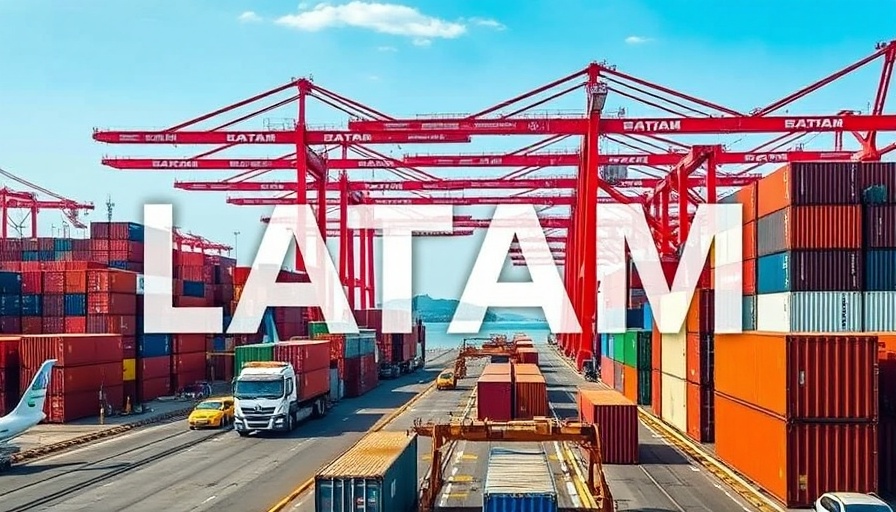
Understanding the New Landscape of LATAM’s Critical Minerals
As the global visibility of critical minerals intensifies, the spotlight on Latin America grows brighter. With countries like Chile, Argentina, and Bolivia at the helm of lithium production and Peru leading in copper, this region has emerged as a linchpin in global commodity markets. The recent analyses by EBC Financial Group reveal how shifting trade dynamics, particularly U.S. tariffs, could drastically alter the trajectory of Latin America's mineral market. The pent-up demand for materials crucial to renewable energy endeavors positions LATAM to capitalize on its abundant resources amidst evolving geopolitical imperatives.
The Growing Importance of Critical Minerals
With projections from the International Energy Agency suggesting demand for copper could increase by 50% and lithium demand potentially skyrocketing by sevenfold by 2040, the global economy is at a precipice. This demand surge is largely driven by the electrification boom and the shift towards electric vehicles (EVs) and smart technologies. EBC Financial Group underscores that LATAM's mineral-rich deposits not only place it at the center of this transition but also set the stage for significant economic growth and trade evolution.
How U.S. Trade Policies Impact LATAM Mining
U.S. tariffs are reshaping the commodities landscape, introducing unpredictability for Latin American economies. The potential for reimposition of duties—especially under a new Trump administration—means that countries such as Colombia, Mexico, and Brazil must brace themselves for economic shifts. Trade relationships built on cooperative agreements could be jeopardized, forcing countries to reevaluate their offerings in the global market. A detailed examination of historical context shows that similar trade strategies could trigger a wave of retaliatory measures, creating both risks and opportunities for LATAM exporters.
Trade Wars: Historical Context and Future Outlook
Reflecting on the trade wars instigated during Trump's first tenure, it is evident that unilateral trade measures can have widespread repercussions. While some producers have capitalized on the situation, many sectors, especially agriculture, have faced severe strain. Should these policies resurface, countries reliant on the U.S. market may encounter challenges, while others may benefit from new export avenues as global supply chains adjust. Insights hint at a model where countries like Brazil and Argentina could explore new trade partnerships, bolstering their presence in third markets.
Multiple Perspectives on Trade Interdependence
The stark contrast in dependency on the American market across LATAM highlights an important counterargument. Not all countries will be equally affected by tariff adjustments—Mexico stands vulnerable, with nearly 92% of its agricultural exports going to the U.S., while countries like Brazil exhibit more resilience due to diversified export markets. This dynamic forces a reconsideration of how trade policies impact varying economic structures within LATAM, ultimately fostering a need for these nations to expedite their economic diversifications.
Investment Flows and Economic Projections
As investment flows pivot toward LATAM's critical minerals, strategic insights from EBC suggest that mining corporations are aligning their interests with the anticipated shifts in commodity demands. Infrastructure developments and regulatory frameworks crafted by local governments aim to bolster extraction and export capabilities. These trends herald the dawn of new economic landscapes within these nations, positing LATAM not merely as resource providers but as proactive players in global supply chains.
The Potential for Renewed Trade Conflicts
Uncertainty clouds the trade environment, emphasizing the need for vigilance among stakeholders. As outlined in research from IFPRI, potential increases in tariffs are likely to invoke counter-retaliatory actions, creating a ripple effect that could disrupt established global trading patterns. Echoing past trade wars, the need for strategic pivots becomes ever more critical for LATAM exporters in encountering increased competition.
Conclusion: Navigating the Future
In conclusion, as the world pivots toward more sustainable technologies, the fates of Latin America's mineral-rich nations are inextricably linked to U.S. trade policies. With critical minerals at the forefront of global consumption patterns, understanding the interplay of tariffs, trade relationships, and investment flows becomes pivotal for practitioners and policymakers alike. As the landscape continues to evolve, LATAM's critical minerals market emerges as not only a crucial player but as a determinant of future economic stability.
 Add Row
Add Row  Add
Add 




Write A Comment